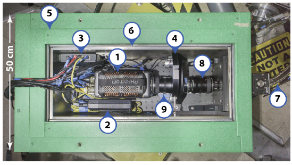Imaging divertor strike point splitting in RMP ELM suppression experiments in the DIII-D tokamak [Imaging divertor strike point splitting in RMP ELM suppression experiments]
- Univ. of California San Diego, La Jolla, CA (United States)
- General Atomics, San Diego, CA (United States)
- Univ. of California, Los Angeles, Los Angeles, CA (United States)
- Oregon State Univ., Corvallis, OR (United States)
- Lawrence Livermore National Lab. (LLNL), Livermore, CA (United States)
- Oak Ridge Associated Univ., Oak Ridge, TN (United States)
- Sandia National Lab. (SNL-CA), Livermore, CA (United States)
Fast visible imaging of the lower divertor from above is used to study the structure and dynamics of lobes induced by resonant magnetic perturbations (RMPs) in Edge-Localized Mode (ELM) suppression experiments in DIII-D. The best compromise between the amount of light and sharp imaging was obtained using emission at 601 nm from Fulcher band molecular deuterium. Multiple spatially resolved peaks in the D2 emission, taken as a proxy for the particle flux, are readily resolved during RMPs, in contrast to the heat flux measured by infrared cameras, which shows little spatial structure in ITER-like conditions. The 25 mm objective lens provides high spatial resolution (2–4 mm/pixel) from the centerpost to the outer shelf over 40° toroidally that overlaps the field of view of the IRTV that measures the divertor heat flux, allowing direct comparison in non-axisymmetric discharges. The image is coupled to a Phantom 7.3 camera using a Schott wound fiber bundle, providing high temporal resolution that allows the lobe dynamics to be resolved between ELMs and across ELM suppression onset. Furthermore, these measurements are used to study the heat and particle flux in 3D magnetic fields and to validate models for the plasma response to RMPs.
- Research Organization:
- Lawrence Livermore National Lab. (LLNL), Livermore, CA (United States)
- Sponsoring Organization:
- USDOE National Nuclear Security Administration (NNSA)
- Grant/Contract Number:
- AC52-07NA27344
- OSTI ID:
- 1542708
- Alternate ID(s):
- OSTI ID: 1466875
- Report Number(s):
- LLNL-JRNL-777842; 963969
- Journal Information:
- Review of Scientific Instruments, Vol. 89, Issue 10; ISSN 0034-6748
- Publisher:
- American Institute of Physics (AIP)Copyright Statement
- Country of Publication:
- United States
- Language:
- English
Web of Science
Assessment of equilibrium field coil misalignments on the divertor footprints in NSTX-U
|
journal | June 2019 |
Injection of multiple shattered pellets for disruption mitigation in DIII-D
|
journal | September 2019 |
Divertor currents during type-I edge-localized modes on the DIII-D tokamak
|
journal | October 2019 |
Similar Records
Integrated ELM and divertor power flux control using RMPs with low input torque in EAST in support of the ITER research plan
Divertor heat loads in RMP ELM controlled H-mode plasmas on DIII-D*






